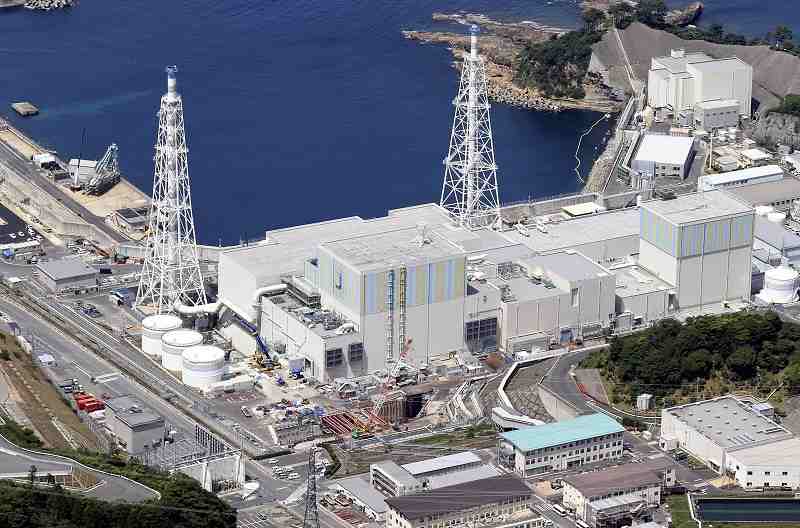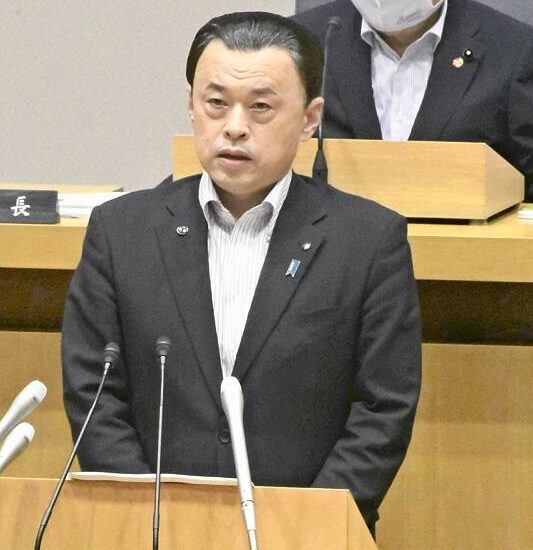
The Chugoku Electric Power Co.’s Shimane nuclear power station in Matsue
17:00 JST, June 3, 2022
The decision to approve the restart of a nuclear reactor in Shimane Prefecture was made quickly and proceeded relatively smoothly after the plant passed a safety inspection nine months ago. Local governments in other parts of the country, however, have struggled to make similar progress due to faltering at the screening stage or failing to overcome local opposition.
Shimane Gov. Tatsuya Maruyama on Thursday authorized the restart of the No. 2 reactor at Chugoku Electric Power Co.’s Shimane nuclear plant in Matsue, the only nuclear plant in Japan located in a prefectural capital.
“In making a decision on the restart, we should never forget the accident at Tokyo Electric Power Company Holdings Inc.’s Fukushima No. 1 nuclear plant,” Maruyama said after green-lighting the restart at a plenary session of the Shimane prefectural assembly meeting on the day.
The Shimane No. 2 reactor is a boiling water reactor, or BWR — the same as that used in the Fukushima No. 1 plant.
Since the Fukushima accident, five BWRs across the country have met new regulatory standards and passed inspections, though none have restarted. In light of these circumstances, Maruyama likely thought very carefully before making his decision.
About 460,000 people live within a 30-kilometer radius of the Shimane plant.
From October to November, the prefectural government held explanatory meetings at seven locations in four cities in the prefecture, with the aim of gaining local residents’ understanding. Some participants voiced concerns over such issues as the viability of the evacuation plan and whether people with disabilities would be able to evacuate safely. But in February, the plant’s host city, Matsue, agreed to resume operations. By March, the Tottori prefectural government and five cities near the plant had all approved the plan, and the Shimane prefectural assembly ratified the restart on May 26.
In October last year, Chugoku Electric held briefing sessions for residents in six cities in Shimane and Tottori prefectures. At each of the seven sessions, executives from the plant’s headquarters explained in detail why they thought the restart was necessary.
The briefings seemed to allay lingering fears over the restart, and during Thursday’s plenary session, Maruyama deemed that the No. 2 reactor was safe. “Under the current circumstances, a restart is unavoidable,” he said.

Shimane Gov. Tatsuya Maruyama speaks at a plenary session of the Shimane prefectural assembly on Thursday.
Prolonged screening
The road to the restart decision ran relatively smoothly from passing the screening to gaining local approval. However, the screening process took seven years and eight months: Chugoku Electric initially applied to the Nuclear Regulation Authority (NRA) to start the process in December 2013.
During the assessment phase, it was announced that the Shinji Fault, which lies about 2 kilometers south of the plant, was possibly longer than originally estimated. Based on this new finding, Chugoku Electric spent 20 months conducting an additional survey, which prolonged the screening.
The NRA itself also caused the screening to be pushed back. From August 2015 to March 2016, the NRA put priority on screening reactors No. 6 and No. 7 at TEPCO’s Kashiwazaki-Kariwa nuclear power plant.
“The delay [in screening the Shimane No. 2 reactor] was related to the screening of other power plants,” NRA Chairman Toyoshi Fuketa said at a press conference in June 2021, adding that the watchdog did not have enough personnel to properly screen the Shimane plant.
More than six years have passed since the eight nuclear power plants currently being screened — excluding those under construction — first applied for the process.
This slow pace is partly due to poor administration by the power companies. For example, nearly nine years have elapsed since Hokkaido Electric Power Co.’s Tomari nuclear plant filed its restart application in July 2013.
But the company’s failure to provide evidence about fault activity under the site of its plant caused delays. In May, the Sapporo District Court ruled against restarting operations at the plant, citing safety concerns.
Last year at the Kashiwazaki-Kariwa nuclear plant in Niigata Prefecture, an employee used another person’s ID card to illegally enter the main control room. Local residents reportedly lost trust in the operator following the incident and TEPCO has yet to regain consent to restart the reactors.
“Electric power companies should communicate effectively with regulators during the screening process,” said Hiroshi Miyano, a former visiting professor at Hosei University who specializes in nuclear reactor systems. “They should also strive to keep the trust of local people, such as by carrying out structural reviews.”
"Society" POPULAR ARTICLE
-

M4.9 Earthquake Hits Tokyo, Neighboring Prefectures
-

M7.5 Earthquake Hits Northern Japan; Tsunami Waves Observed in Hokkaido, Aomori and Iwate Prefectures
-

Israeli Tourists Refused Accommodation at Hotel in Japan’s Nagano Pref., Prompting Protest by Israeli Embassy and Probe by Prefecture
-

Tsukiji Market Urges Tourists to Avoid Visiting in Year-End
-

M5.7 Earthquake Hits Japan’s Kumamoto Pref., Measuring Upper 5 Intensity, No Tsunami Expected
JN ACCESS RANKING
-

Keidanren Chairman Yoshinobu Tsutsui Visits Kashiwazaki-Kariwa Nuclear Power Plant; Inspects New Emergency Safety System
-

Imports of Rare Earths from China Facing Delays, May Be Caused by Deterioration of Japan-China Relations
-

University of Tokyo Professor Discusses Japanese Economic Security in Interview Ahead of Forum
-

Japan Pulls out of Vietnam Nuclear Project, Complicating Hanoi’s Power Plans
-

Govt Aims to Expand NISA Program Lineup, Abolish Age Restriction

















